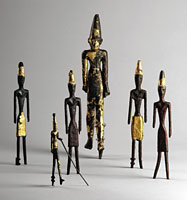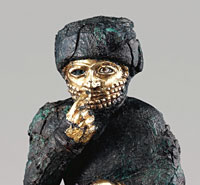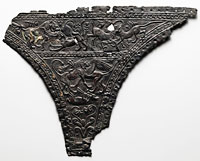Bronze Age Discovery Mirrors Modern Era
Shipwreck exhibit reveals the alchemy that forged our civilization
Ten parts copper, one part tin. It sounds like a simple equation, but the discovery of this formula-the essential proportions of bronze metal-set in motion world-changing events, forever altering life on our planet by ushering in the modern era of metalworking, mechanical invention and more.
 These figures are made of copper alloy and gold. They date back to the Middle Bronze Age, early second millenium B.C.
These figures are made of copper alloy and gold. They date back to the Middle Bronze Age, early second millenium B.C. High-resolution version of this photo.
The questions of exactly when, where and how the Bronze Age actually began remain unanswered, lost in time-archeologists date the era somewhere between 3300 and 1100 B.C. But an exhibit underway at New York's Metropolitan Museum of Art offers a revelation as to why the discovery of bronze alchemy helped to unite and elevate the disparate mud-walled kingdoms of that time, literally forging civilization as we know it today.
The exhibit centers around a shipwreck found in the Mediterranean Sea off Uluburun on the coast of Anatolia, or what is now Turkey. Among the artifacts recovered from the ship, a trading vessel dating from the late 13th century B.C., were two consignments of metal-10 tons of copper and one ton of tin.
According to one reviewer, the exhibit illustrates "how the Bronze Age could only have existed through the combining of two raw materials found in geographic locations far apart-tin from Afghanistan and copper from Turkey."
Considering the near-prehistoric state of civilization in that era, it's clear that bronze represented the material that not only was a critical foundation of human progress, but also the magnetic force that drew together people and cultures from as far apart as Asia Minor and Eastern Europe. Few discoveries can claim historical importance of such magnitude.
"The quest for copper and tin to make bronze is what fueled the burst of creativity in the Bronze Age," explains Joan Aruz, the exhibit curator. And the resulting trade during that time formed "the backbone of the interaction that took place in the second millennium."
Fast-forward a few millennia to the 21st century, and the influence of the Bronze Age continues to resonate in the modern world. In many ways, it is as important today as it was at the dawn of civilization.
"It's easy to overlook the incredible contribution that bronze has made to our world," says metallurgist James Michel, a technical services manager with the Copper Development Association (CDA). "When most people think of bronze, they think only about sculptures and statues. But the discovery of bronze-combining two different metals to create an alloy with entirely new properties-set the stage for human development well beyond what was achievable using materials in their original state."
 Made of bronze, gold and silver, this kneeling worshiper dates back to 1760 B.C. from the Mesopotamia region.
Made of bronze, gold and silver, this kneeling worshiper dates back to 1760 B.C. from the Mesopotamia region. High-resolution version of this photo.
While copper, the first metal used by mankind, was used extensively for more than a thousand years before bronze came about, bronze was prized for its superior durability and hardness, as well as its beauty. Early adopters put bronze to work as tools, weapons, ornamentation and sculpture. Numerous examples of bronze metalwork were found in the burial chambers of King Tutankhamun, the now-famous Egyptian boy king. They included sculptures of animals, swords, candleholders and a trumpet-one of the earliest known examples of metal musical instruments.
Today, bronze alloys are indispensable in applications ranging from deep-sea drilling to aerospace exploration. The massive screws, or propellers, on large ocean-going ships typically are bronze, as are the bearings that separate high-speed moving parts in transportation vehicles, pumps and industrial machinery. And bronze brazing material helps to make stronger welds. Architectural facades and statues resist corrosion and maintain their natural beauty over centuries of exposure to the elements, while bronze tools, which don't spark when they strike hard or metal objects, are specially designed for potentially explosive environments such as mines and space capsules.
According to CDA's Michel, unlike many all-purpose metals and alloys, bronzes are highly valued because they can be engineered for specific purposes.
Metallurgists have tinkered with the original copper-tin formula over the centuries, creating an entire "family" of bronzes that contain small but critical amounts of aluminum, nickel, silver, manganese, phosphor, silicon and other elements that result in alloys with widely differing properties. Depending upon their makeup, bronzes also vary widely in color, from brassy gold to a deep brown-black, and are favored by artists and architects for decorative applications.
As valuable as bronze was to ancient civilizations, today it and other copper-based alloys like brass and copper-nickel are being recognized anew as being beneficial to mankind in an altogether different way. Scientific testing has recently confirmed that copper and certain copper alloys are inherently antimicrobial. In other words, certain bacteria*, die within two hours when they come in contact copper alloys.
The U.S. Environmental Protection Agency (EPA) has registered 275 copper alloys as antimicrobial materials. The registration was granted based on independent laboratory tests demonstrating that, when cleaned regularly, uncoated copper, brass and bronze are extremely effective in killing disease-causing bacteria*, including Methicillin-resistant Staphylococcus aureus (MRSA), one of the most virulent strains of antibiotic-resistant bacteria and a common cause of hospital- and community-acquired infections. These alloys supplement the standard cleaning practices in healthcare and other environments; they don't replace those practices. In essence, they are another tool in the battle against bacteria that can cause healthcare-associated infections.
 This bronze plaque depicts animal combat and dates back to the Late Bronze Age, 14th Century B.C.
This bronze plaque depicts animal combat and dates back to the Late Bronze Age, 14th Century B.C.
High-resolution version of this photo.
Clinical trials funded by the U.S. Department of Defense are now being conducted at three U.S. hospitals to evaluate the bacteria-killing potential of copper alloy surfaces. If the results prove as positive as proponents anticipate, materials such as bronze and brass may one day replace many of the plastic and stainless steel surfaces in homes, public buildings and facilities where disease-causing bacteria collect.
In many ways, this latest revelation brings bronze full circle in historical and social terms. Many ancient cultures used copper and copper alloys as curatives for infection and other ailments. Even the excavators of the Uluburun shipwreck noted that the slowly corroding copper in the ship's hold created an environment that "kept away predatory marine organisms … preserving the hull timbers" and other artifacts found on the seabed after thousands of years.
Now, the same metal that rocked the cradle of civilization, that enabled the kingdoms of Babylonia, Egypt and Troy, is being viewed as a formidable ally in modern mankind's ongoing battle against a biological scourge that until today has defied an easy remedy.
Perhaps those early sea-traders, whose artifacts provide a window into a bygone era, knew far more than we understand.
*Testing demonstrates effective antibacterial activity against Staphylococcus aureus, Enterobacter aerogenes, Methicillin-resistant Staphylococcus aureus (MRSA), Escherichia coli O157:H7, and Pseudomonas aerginosa. Cu
